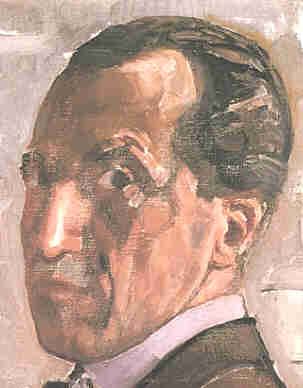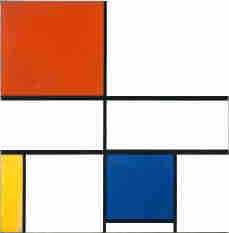Mondrian carried abstraction to its furthest limits. Through radical simplification of composition and color, he sought to expose the basic principles that underlie all appearances. [click on image for full self-portrait >]
 Born in Amersfoort, the Netherlands, Mondrian embarked on an artistic career
over his family's objections, studying at the Amsterdam Academy of Fine
Arts. His early works, through 1907, were calm landscapes painted in delicate
grays, mauves, and dark greens. In 1908, under the influence of the Dutch
painter Jan
Toorop, he began to experiment with brighter colors; this represented
the beginning of his attempts to transcend nature. Moving to Paris in 1911,
Mondrian adopted a cubist-influenced style, producing analytical series
such as Trees (1912-1913) and Scaffoldings (1912-1914).
He moved progressively from seminaturalism through increased abstraction,
arriving finally at a style in which he limited himself to small vertical
and horizontal brushstrokes.
Born in Amersfoort, the Netherlands, Mondrian embarked on an artistic career
over his family's objections, studying at the Amsterdam Academy of Fine
Arts. His early works, through 1907, were calm landscapes painted in delicate
grays, mauves, and dark greens. In 1908, under the influence of the Dutch
painter Jan
Toorop, he began to experiment with brighter colors; this represented
the beginning of his attempts to transcend nature. Moving to Paris in 1911,
Mondrian adopted a cubist-influenced style, producing analytical series
such as Trees (1912-1913) and Scaffoldings (1912-1914).
He moved progressively from seminaturalism through increased abstraction,
arriving finally at a style in which he limited himself to small vertical
and horizontal brushstrokes. In 1917 Mondrian and the Dutch painter Theo van Doesburg founded De Stijl magazine, in which Mondrian developed his theories of a new art form he called neoplasticism. He maintained that art should not concern itself with reproducing images of real objects, but should express only the universal absolutes that underlie reality. He rejected all sensuous qualities of texture, surface, and color, reducing his palette to flat primary colors. His belief that a canvas—a plane surface—should contain only planar elements led to his abolition of all curved lines in favor of straight lines and right angles. His masterly application of these theories led to such works
 as
Composition
with Red, Yellow, and Blue (1942, 39x35cm), in which the painting,
composed solely of a few black lines and well-balanced blocks of color,
creates a monumental effect out of all proportion to its carefully limited
means. [< image]
as
Composition
with Red, Yellow, and Blue (1942, 39x35cm), in which the painting,
composed solely of a few black lines and well-balanced blocks of color,
creates a monumental effect out of all proportion to its carefully limited
means. [< image]When Mondrian moved to New York City in 1940, his style became freer and more rhythmic, and he abandoned severe black lines in favor of lively chain-link patterns of bright colors, particularly notable in his last complete masterwork, Broadway Boogie-Woogie (1943, 127x127cm). Mondrian was one of the most influential 20th-century artists. His theories of abstraction and simplification not only altered the course of painting but also exerted a profound influence on architecture, industrial design, and the graphic arts. Mondrian died in New York.
— [Nederlands biografie]
— LINKS
— Self Portrait (1918)
— River View with Boat (1908)
— Little Girl (1901) — Still Life with Gingerpot II
— Composition with Large Blue Plane, Red, Black, Yellow, and Gray (1921)
— Composition blanc, rouge et jaune (1936) — River View with Boat (1908)
— Molen (Mill); Mill in Sunlight — Avond (Evening); Red Tree (1908 )
— Amaryllis (1910) — Gray Tree (1911) — Composition No. II; Composition in Line and Color (1913)
— Ocean 5 (1915) — Composition with Color Planes and Gray Lines 1 (1918)
— Composition with Gray and Light Brown (1918)
— Composition A: Composition with Black, Red, Gray, Yellow, and Blue (1920)
— Lozenge Composition with Yellow, Black, Blue, Red, and Gray (1921)
— Composition with Red, Yellow and Blue (1921)
— Composition with Blue, Yellow, Black, and Red (1922)
— Lozenge Composition with Red, Black, Blue, and Yellow (1925)
— Fox Trot; Lozenge Composition with Three Black Lines (1929)
— Composition with Yellow Patch (1930) — Composition with Yellow (1930)
— Composition No. III Blanc-Jaune (1942) — Rhythm of Black Lines (1942)
— Vertical Composition with Blue and White (1936) — Composition No. 8 (1942)
— Composition No. 10 (1942) — New York City (1942) — Broadway Boogie Woogie (1943)
— Solitary House (1898) — Composition with Oval in Color Planes II (1914)
— Composition with Grid VII (Lozenge, 1919) — Composition with Grid IX (1919)
— Composition A (1920) — Composition with Black, Red, Gray, Yellow, and Blue (1921)
— Lozenge Composition with Red, Gray, Blue, Yellow, and Black (1925)
— Place de la Concorde (1943) — New York City I (1942) — Victory Boogie Woogie (1943)